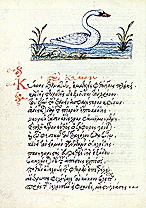 |
|
 |
Introduction
 he literature of the late Byzantine period is
he literature of the late Byzantine period is
 characterised, as are other sectors of
intellectual life and creation, by a revival of classical studies, that is the study of Greek and Latin literature, and by a
humanisti
c movement, by the development, that is, of a secular literature distinct from religious literature. characterised, as are other sectors of
intellectual life and creation, by a revival of classical studies, that is the study of Greek and Latin literature, and by a
humanisti
c movement, by the development, that is, of a secular literature distinct from religious literature.
The texts that have survived and testify to these movements in literature can generally be grouped into two categories. The first consists of the poems of
Manuel Philes,
John Pediasimos
and
Maximos Mazaris, of religious
literature (that is works
with a theological content) and of great historiographic works. These works were written by scholars of the period in a style recalling that of classical literature: the language in which they were written is known as
atticism, the manner was elaborate,
and laid claim to high literary quality. They were thus addressed to an elite, to those, in other words, who were to some
degree already familiar with the Classics. The works of the second category were also written by scholars, but in a totally different mode: the language was simpler, the literary form more popular. To distinguish this category from the former one, this second group has been qualified as "Palaiologan popular literature": it comprised chronicles, short historical accounts and romances in verse, all of which were addressed to a wider public.
|